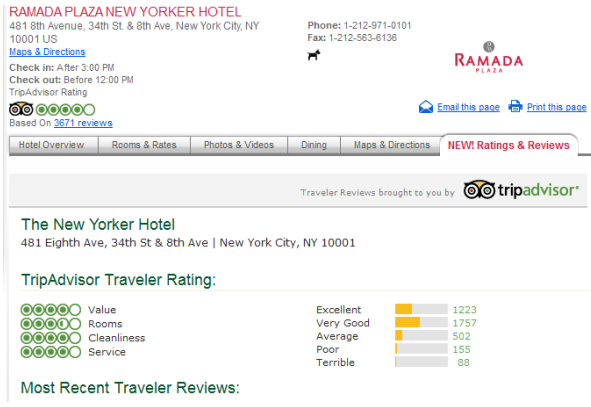Keeping consumers on site: a review of the process
IN-DEPTH: Hotels are constantly looking at ways to keep consumers on their own sites for as long as possible. Hotels like the Wyndham Group are deploying a range of tactics such as functional enhancements to improve conversion rates and publishing reviews to be as transparent as possible. Ritesh Gupta finds out how this group is getting on.
If you can’t beat them join them. Like many hotel groups Wyndham has recognised that there is no stopping the tide of reviews and how important they have become in the online room booking process.
Indeed savvy travellers understand the context of reviews better now and they realise that there is a difference between how a person they know rates a property, what an expert travel authority says about a hotel and what an aggregated voice of the community tells them.
So over the last year, a range of hotel companies (like Starwood and Wyndham but also small boutique chains like Hollman Beletage) – have chosen to feature reviews on their own websites. Some hotel companies have approached this in different ways, launching their own platforms to share user-generated content and tying up with review sites as well. One thing is clear hotel companies want consumers to stay on their own sites.
Delivering tangible results
So is the decision to display reviews paying off?
Wyndham Hotel Group says it is witnessing positive results. The group announced a new partnership with TripAdvisor in March this year with the two agreeing to display its ratings, reviews and opinions on the Wyndham Rewards loyalty programme site. There are also plans to expand TripAdvisor content to 11 of the group’s brands this year.
“We have made key investments in our digital assets over this last year in order to maximise our own channels and drive more direct business to owners and operators,” says Gareth Gaston, senior vice president, global eCommerce, Wyndham Hotel Group, adding that “because of these efforts, we have seen the highest contributions yet and online direct growth is now outpacing intermediaries and OTAs.”
Not only has Wyndham refreshed all of its brand websites with new designs and TripAdvisor reviews, but the group also introduced WyndhamHotelGroup.com, a new website designed to let consumers engage with its complete family of brands while driving incremental bookings for hotel owners.
In addition, to tap into a surging market, the firm has launched new mobile sites for all brands and this year will introduce a series of mobile apps.

Differentiation is really important
Hotel companies have been trying to let bookers get closer to knowing what they are booking and according to Gaston a major pillar of Wyndham’s direct strategy is transparency. “In working with TripAdvisor, we are now able to provide our guests with a one-stop-shop experience, allowing them to read reviews and view ratings without ever leaving our websites,” he says. The hotel recognises that 50% of travellers will not book a stay until they read a review, so it is “providing them with what they want, right where they are shopping.”
It is imperative to assess how hotel companies measure their success versus other industry players like online travel agents. There are four areas worth considering:
1. Planning stage:
Lots of customers don’t have fixed ideas about their destination when they’re searching online for the best deals. But efforts are being made to provide them with a creatively designed search interface and relevant results. “With brands that fall within almost every segment, Wyndham Hotel Group has a hotel for every trip. So, unlike OTAs where consumers make booking decisions based on generic content offerings for thousands of properties, we are able to provide guests with the full brand experience no matter the destination,” says Gaston. Not only can travellers fully engage with a property in the destination they want, but they can tailor their search on Wyndham pages by price, brand, TripAdvisor ranking, and amenities. “This allows us to sell all of our brands while providing consumers with the benefits of booking direct,” he says.
2. Attractive online offering:
Gaston argues that through its own channels, the group provides consumers with guaranteed low rates, no required payment upfront, and the convenience and flexibility to change reservations. Plus consumers also get to take advantage of deals and promotions specific to its brands and the benefit of earning and redeeming points with the Wyndham Rewards loyalty programme.
3. Improving conversion
Wyndham has an ongoing roadmap of functional enhancements. But in addition it has made major investments in a dedicated optimisation function and tools that show how the consumer is behaving and thinking and lets the group test different scenarios to improve conversion. For instance, with a change in the colour of action buttons and by moving around features on the search results page, Wyndam has seen around a 70% improvement in click-throughs from that page.”
4. Mobile
Beyond TripAdvisor, the industry has seen mobile technologies have a significant impact on how it does business. “Since so many of our guests drive to their lodging destinations, we have made a significant investment in developing our mobile websites,” Gaston says. These were specifically designed to complement the unique look and feel of each brand while delivering less clicks and fast booking with an express book feature that allows consumers to reserve a room without the use of a credit card.

